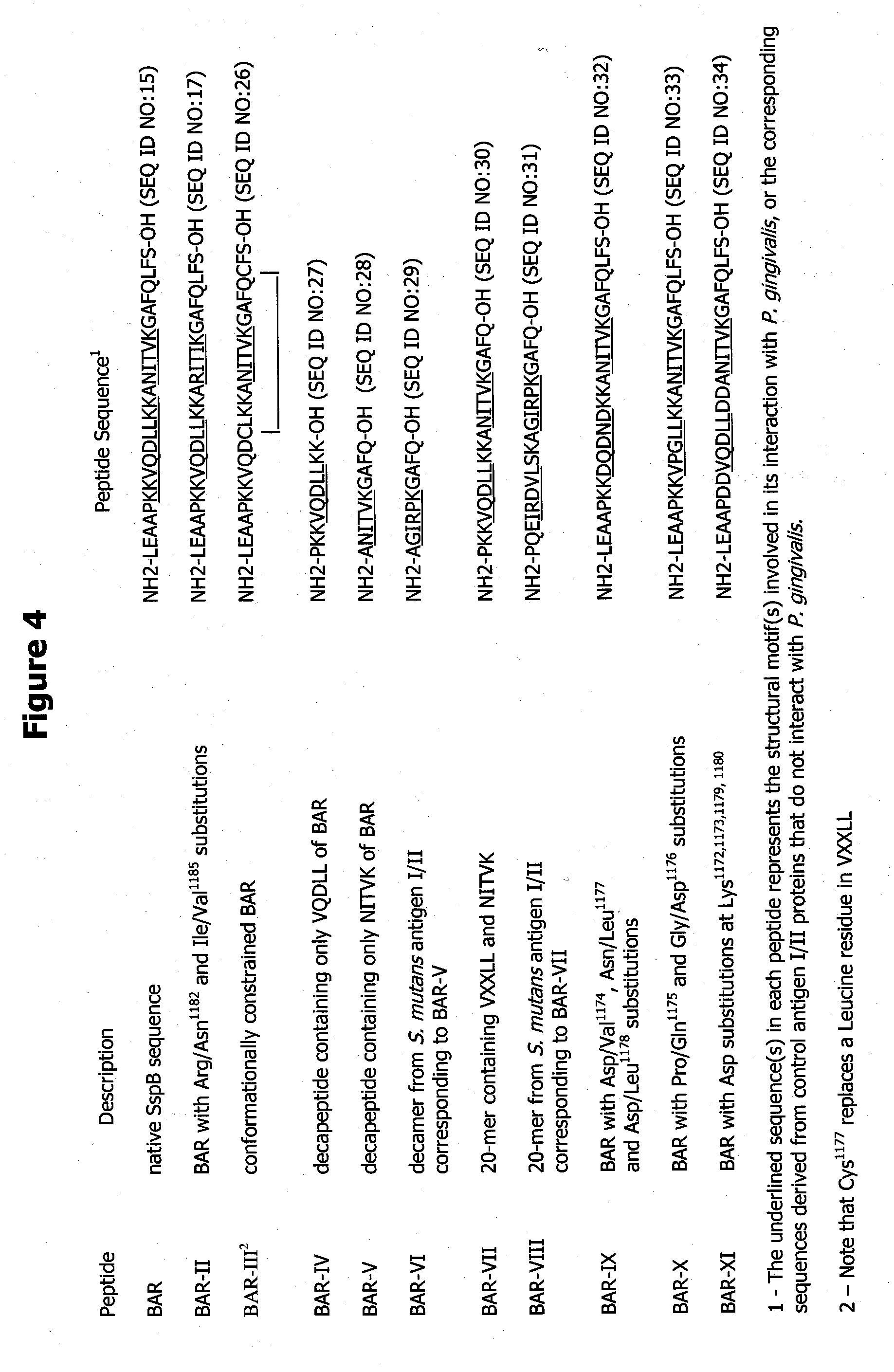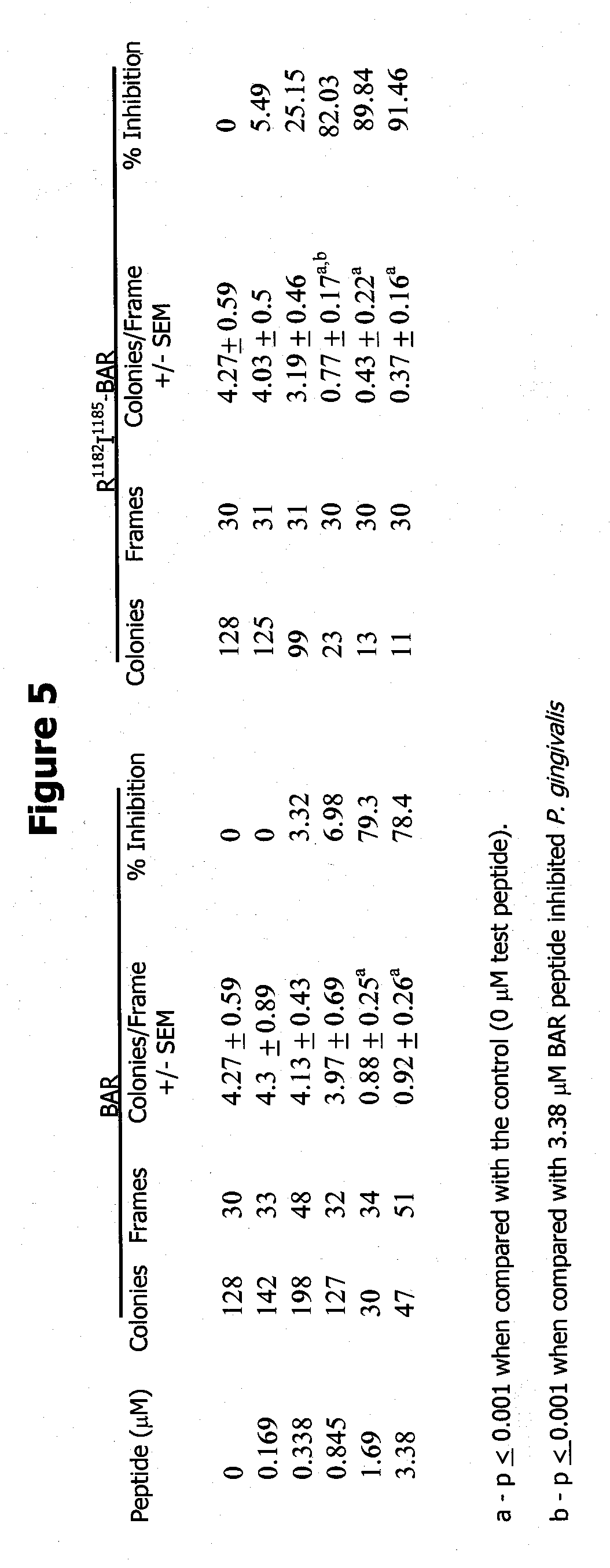Synthetic peptides
a technology of synthetic peptides and peptides, applied in the direction of peptide/protein ingredients, dispersed delivery, antibacterial agents, etc., can solve the problem of no pathogen specific treatment available for oral diseases
- Summary
- Abstract
- Description
- Claims
- Application Information
AI Technical Summary
Benefits of technology
Problems solved by technology
Method used
Image
Examples
example 1
Synthesis of Variant BAR Peptides
[0267]The inventor synthesized a peptide, SspB Adherence Region (BAR) representing the region of SspB that was shown to be involved in the interaction of P. gingivalis with S. gordonii. This peptide was shown to inhibit the development of P. gingivalis biofilms on a substrate of S. gordonii cells attached to a saliva coated coverglass in a dose dependent manner. The 150 for BAR was calculated to be about 1.3 μM. The kinetics of inhibition were also similar to the kinetics of association of the BAR peptide with its receptor on P. gingivalis, the minor fimbrial protein Mfa. Within BAR, the NITVK motif was shown to be important for P. gingivalis adherence. To further characterize the SspB-Mfa interacting interface, the inventor screened a biased combinatorial library using the BAR peptide as the lead compound in which the active amino acids in the NITVK motif were randomized. The inventor showed that substitution of basic amino acids or serine for N1182...
example 2
Optimization of BAR Peptides
[0286]Porphyromonas gingivalis initially colonizes the oral cavity by interacting with organisms in supragingival plaque, such as the oralis group of oral streptococci. This interaction involves association of the streptococcal antigen I / II with the minor fimbrial antigen (Mfa1) of P. gingivalis. Our previous studies showed that a peptide (BAR) derived from antigen I / II inhibits P. gingivalis adherence and subsequent biofilm formation on streptococcal substrates. In addition, screening a combinatorial peptide library identified select amino acid substitutions in the NITVK active region of BAR that increased adherence of P. gingivalis to streptococci. Here we report that incorporating these residues in a synthetic peptide results in more potent inhibition of P. gingivalis adherence and biofilm formation (I50=0.52 μM versus I50=1.25 μM for BAR). In addition, a second structural motif in BAR, comprised of the amino acids KKVQDLLKK (SEQ ID NO: 13) was shown t...
example 3
Disruption of a Pre-Existing Biofilm by Treatment with BAR
[0315]In the examples above and in previous studies by the inventor (Infect Immun. 2006. 74:5756-5762), it was shown that pre-treatment of P. gingivalis cells with BAR prevented its adherence to oral streptococci and inhibited the formation of a biofilm. However, to develop this peptide for therapeutic use against periodontal disease it would also be beneficial to disrupt existing P. gingivalis biofilms in the oral cavity. To determine if BAR disrupts an existing P. gingivalis biofilm, biofilms were generated as in Example 2 but without pre-treatment with BAR. After formation of the P. gingivalis biofilm, it was exposed for up to 2 hours with BAR peptide at a concentration of 10 μg / ml. Analysis of the results by confocal microscopy were as described in Example 2. As shown in FIG. 11, treatment of an existing P. gingivalis biofilm with BAR resulted in a significant reduction of microcolonies over the control culture that was e...
PUM
| Property | Measurement | Unit |
|---|---|---|
| Ratio | aaaaa | aaaaa |
| Polymeric | aaaaa | aaaaa |
| Biostability | aaaaa | aaaaa |
Abstract
Description
Claims
Application Information
 Login to View More
Login to View More - R&D
- Intellectual Property
- Life Sciences
- Materials
- Tech Scout
- Unparalleled Data Quality
- Higher Quality Content
- 60% Fewer Hallucinations
Browse by: Latest US Patents, China's latest patents, Technical Efficacy Thesaurus, Application Domain, Technology Topic, Popular Technical Reports.
© 2025 PatSnap. All rights reserved.Legal|Privacy policy|Modern Slavery Act Transparency Statement|Sitemap|About US| Contact US: help@patsnap.com



